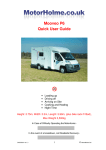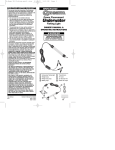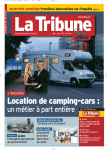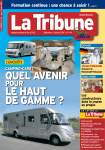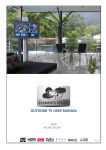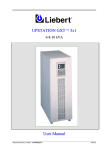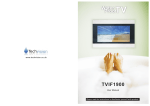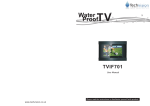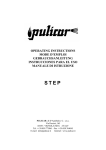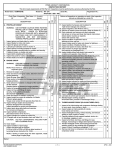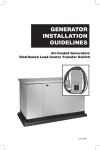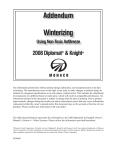Download Mooveo P6 Quick User Guide
Transcript
Mooveo P6 Quick User Guide • • • • • Loading up Driving off Arriving on Site Cooking and Heating Night Time Height: 2.75m, Width: 2.3m, Length: 5.99m, (plus bike rack if fitted), Max Weight 3,500kg In Case of Difficulty Operating the Motorhome:- In the event of a breakdown, call Roadside Recovery:- 24/05/2010 ver 1.3 1 © MotorHolme Ltd Pre-Start Checks There are a lot of items that need to be safely stowed before driving the vehicle. Please follow this checklist – it starts outside, and works forward through the vehicle. 1. Gas off. 2. Bike rack secure. 3. Mains cable stowed and connection cover latched down. 4. Step retracted. (Or free-standing step stowed away) 5. Levelling ramps stowed away. 6. TV Aerial stowed. (To avoid being caught by overhanging branches) 7. Table latches secured. (So the table isn’t thrown towards the driver if you stop abruptly) 8. Bathroom • Toilet valve closed, (slide the lever back), and lid down. • Shower rose placed on the floor of the cubicle. • No loose items in bathroom. • Door locked shut. 9. Fridge: set to 12v, contents secure, and door latched 10. All cupboards and drawers latched shut. (To retain crockery etc). 11. All three roof vents closed. (To avoid being caught by overhanging branches). 12. Gas hob lid down. 13. Interior lights off. 14. Work surfaces clear of loose items. 15. Windows closed and locked. (If they blow open at motorway speed, or brush against hedges, it may rip them off completely). 16. Driver and passenger seat rotation locked. 17. Clean-water tank: Does it need filling? 18. Waste-water tank: Does it need emptying? 19. Toilet: Does it need emptying? 20. Exterior mirror adjustment: Can you see the rear wheels? 21. Remember the vehicle extra length, and be prepared to run wide on corners. 24/05/2010 ver 1.3 2 © MotorHolme Ltd The Mooveo Fiat Cab Seat rotation release is towards the front of the inboard side of the seat Bonnet Release Diesel Filler Seat height adjusters, front and back Cab Air-conditioning Switch 5 or 6 speed Gearbox Lock yourself in at night Instead of a spare wheel, this vehicle carries a foam tyre repair kit and an electric pump plugs into the cigarette lighter socket to re-inflate the tyre in the event of a puncture. Tool Kit 24/05/2010 ver 1.3 3 © MotorHolme Ltd Driving a Large Vehicle The dimensions of this vehicle are printed on the front cover. Width: Although it appears big, the van is actually not much wider than an ordinary car. The exterior mirrors are the widest part of the vehicle, and they give you a good “feel” for the width. Be careful though, about getting too close to trees and hedges. Strong branches hidden among the leaves frequently scratch the sides of motorhomes. Some countries require drivers to fold external mirrors inward when parked. Length: The rear wheels are significantly further back from the driver than in a normal car. As a result it is very easy to turn too soon and have the rear wheels bumping over the kerb, or worse, to scrape the side of the van against something. The trick is to turn later, running wider on corners and at junctions. Adjust each external mirror so that you can see both the kerb and the rear wheel. Then as you turn, glance in the mirror, and you will quickly learn when to turn. Height: Arches or low bridges are an obvious hazard. Wheel and kerb Also watch out for low roofs, and overhanging tree branches, particularly when you are squeezing into the side of a narrow road to avoid an oncoming vehicle and your attention is focused at ground level. Parking: The vehicle is too tall to fit in most multi-storey car parks, and longer than most on-street parking bays. If you effectively occupy two parking bays, it is safer to buy two parking tickets. Some car parks have high-level barriers that are open during the day, but are closed in the evening, and could prevent your tall vehicle from leaving. Reversing: Ask your passenger to walk and guide you. Explain that you can see them only if they can see you in the mirrors. Open both front windows, so you can hear them. Fuel Economy: Motorhomes are not very aerodynamic. You will use about 20% less fuel at 60mph than at 70. Passengers must remain seated with seat belts fastened whenever the vehicle is moving. Weight Distribution and Stability. Motorhomes are tall vehicles and will sway a little in cross-winds. Minimise this effect by placing heavy items low down in the vehicle – never put them above the cab. 24/05/2010 ver 1.3 4 © MotorHolme Ltd No Smoking There is no smoking inside the van. If you smoke just outside the van, or under any awning that is fitted, be careful that the wind does not take your smoke inside. Smoke is retained by the soft furnishings and leaves a very unpleasant odour for the next nonsmoking user. Fire Prevention A red fire extinguisher is stored behind the driver’s seat. Frying pan or grill fires are probably the greatest fire risk in a motorhome. Don’t try to carry a burning pan outside, as the flames may blow back onto your arms. Use a wet tea towel or a fire blanket to cover flames entirely. Switch off heat, and leave covered until cool. Children – Accompanied at all times It is not safe to leave children unaccompanied in a motorhome. Levelling. If the van is not level, it causes problems with the fridge operation, drainage from the shower tray, and sleeping becomes uncomfortable. If you don’t have a level place to park, you can use levelling ramps to lift one end (or one side) of the van. You should drive forward onto the ramps, and make sure that you firmly apply the handbrake and engage 1st gear. It is helpful for the driver if another person watches as they drive up the ramps. If by accident, you drive right off the end of the ramps, don’t try to go back. The ramps may flip over and become jammed under the bodywork. Move the ramps and try again in the proper direction. 24/05/2010 ver 1.3 5 © MotorHolme Ltd Storage There is additional storage space under seats in the dining area, and a huge area under the double bed. A hatch at the rear of the van give access to the under-bed area from outside Rear Storage Access Door 24/05/2010 ver 1.3 6 © MotorHolme Ltd Water System The van has storage tanks for clean water, and waste “grey” water. Grey water is exclusively what has gone down the drains of the sinks or shower. The toilet is a completely separate system. Clean water is not suitable for drinking without boiling. A separate bottle of drinking water should be carried for that purpose. The clean water tank is filled through a filler on the left side of the vehicle, using the hose supplied. Water is electrically pumped from the tank to the taps, shower, and toilet flush. The pump creates a small positive pressure in the system and then switches off. When any tap is opened, the pressure falls and the pump runs again until the pressure is restored – when the tap is turned off. If the pump can be heard running for no reason, this may be a sign of a leak in the system or a fault in the pump – or a tap left dripping. Water tank levels are indicated on the electrical control panel – see page 9. Waste Water The waste water outlet is below the water filler on the left side. View looking forwards from the back. Empty the wastewater tank over a designated motorhome waste emptying point. Turn the red handle to drain the water, and close it again when empty. Waste Water Outlet Waste Water Tap Do not neglect the emptying of the wastewater tank or dirty water will rise up into the shower tray. Do not put fat or solid material down the sink drain. They can block the drain or accumulate in the tank and cause bad smells. 24/05/2010 ver 1.3 7 © MotorHolme Ltd Toilet Turn on the water pump to enable the electric flush. The whole toilet bowl can swivel to make a little more elbow room. Make sure the red “Cassette Removed” light is not lit. The outlet from the toilet bowl is normally closed with a black sealing “blade”. Move it out of the way by sliding the lever at the base towards the front. After use, flush the toilet using the central button, and close the blade by pushing the lever backwards. (Otherwise if you hit a sleeping policeman too fast, the toilet contents could be ejected.) Open A red warning light shows when the toilet tank is nearly full. This indicates that a capacity of 2 litres is left, allowing approximately 5 more uses, but it is better to empty the toilet earlier. Cassette Removed Cassette Full Flush Cassette ¾ Full Flush water low. 24/05/2010 ver 1.3 8 © MotorHolme Ltd Servicing the Toilet 1. This job is not as bad as you might expect. 2. Inside the van, make sure that the slide valve in the bottom of the toilet pan is closed. (Push the lever in). 3. Go outside, and open the toilet compartment. 4. Lift the yellow latch and withdraw the grey/blue tank. 5. Extend the handle, and tow the cassette to the toilet disposal point. 6. At the disposal point, stand the tank upright, (this keeps the runners on the bottom clean), and swivel the neck upwards. 7. Remove the screw-on cap, and pour away the contents. 8. When you have begun to pour, press down the yellow/green air vent button with your thumb (to avoid splashing). 9. Don’t press the button until you have tipped the tank so the button is above the level of the liquid. 10. Rinse the tank with clean water until it runs clear. 11. The dosage ratios of toilet fluid brands vary, so you must read the bottle to deduce the correct dose for a 19 litre capacity cassette. 12. Use the scale inside the cap to measure the toilet fluid and pour into the tank. 13. Top up with two litres of water. 14. Never add more fluid through the bowl of the toilet. It must always be added through the tank filler cap. 24/05/2010 ver 1.3 15. Don’t forget to wash your hands. 9 © MotorHolme Ltd Electrics The van has a 16amp 230v mains input connection on the right side. This is connected using the long orange cable from the storage compartment. First connect the larger of the two plugs to the van as shown. Then connect the other end of the cable to the socket provided by the campsite. This avoids handling a live connector. There may also be a switch on the campsite socket outlet that must be turned on. If you try and use more than 16amps (about 3.5kW) either the campsite outlet or your motorhome will shut down and need resetting (see Troubleshooting, page 10). In Europe the campsite’s limit may be as low as 7 amps. There is an electrical control panel over the entrance door. Once the van is connected to the mains, the yellow “Mains On” indicator will glow, the mains sockets inside the van will become active, the fridge will change over to use mains electricity, and the van’s batteries will begin to charge up. Water levels: Up = Clean water Down = Dirty water Battery Condition: Up = Leisure Battery Down= Starter Battery Mains On Indicator 12v Leisure Battery Water Pump Besides the normal starting battery for the engine, the van has an additional ‘leisure battery’ which feeds all the appliances in the living area (interior lights, water pump, 12v electrical outlet, fridge, cooker ignition, toilet flush, and water-level gauges) - but only when the mains is not connected. The control panel has switches to turn on the water pump, turn on the leisure battery, and to check the status of the batteries and water tanks. If no water level lights are illuminated, the tank is almost empty. If the red light beside the battery symbol flashes, the leisure battery is very low and needs recharging. If this happens late at night, do not disturb your neighbours by starting the engine for battery charging purposes. If you cannot connect to a mains 230v supply, it is better to turn off all electrical appliances until the morning. 24/05/2010 ver 1.3 10 © MotorHolme Ltd Electrics: Trouble Shooting The van does not generate its own 230v mains supply from batteries. The mains sockets only work when the van is connected to an external mains supply. Otherwise, the electrical equipment is powered from the 12v ‘Leisure Battery’. These circuits must be switched on using the switch above the door. The electrical fuses and switchgear are under the bed. The equipment includes a grey 230v mains circuit breaker, and a blue combined 12v control box and battery charger. If one of the 12v fuses fails, it may be replaced only once. If it fails again you should leave the circuit off, and call the number on the front of this manual. Do not replace a failed fuse with one of a higher rating. This would risk the cables overheating and causing a fire RCCD safety trip test button Overload trips Main switch If one of the 230v mains systems develops a fault, it may be necessary to reset the mains switches by pushing them up. If the problem happens again, leave the circuit off and call the number on the front of this manual. Make a note to report any temporary electrical faults at the end of your holiday so that they can be investigated before the next trip. 24/05/2010 ver 1.3 11 © MotorHolme Ltd Gas The cylinders are accessed from outside the van. The gas must be turned off when driving, and it is illegal to use gas devices in petrol filling stations, indoor car parks, and ferries – due to the ignition hazard when fuel vapour is present. If you shake a cylinder you can feel and hear whether it is empty. Cylinders can be exchanged at campsites, and some petrol stations. Calor use a 21mm outlet for butane. Some other suppliers use a 22mm outlet that will not fit the same regulator. Blue Butane cylinders are switched on and off using a black lever on the cylinder. Press the same lever inwards to release the hose connection and change the cylinder. Simply press the hose fitting onto the new cylinder, and open the valve. If it won’t open, you must wriggle the valve further down onto the cylinder. Always secure the cylinders with their waist straps. Red Propane cylinders are preferred for all year round camping because Butane suffers from reduced gas flow in cold weather. Unscrew the knob anti-clockwise to turn on the gas. To change a cylinder, use the spanner provided. ON OFF Release The connection has a left hand thread, so as in the picture shown, you should turn the spanner clockwise to release. Gas is fed into a pressure regulator on the bulkhead beside the gas cylinder. Any valve there is normally left on. Finally, there are distribution valves inside the under-sink drawer. These give separate control over which appliances receive gas:• Cooking hob • Oven/Grill • Fridge The valves are normally left “ON”, and are turned through 90 degrees to turn off. If you smell gas • Turn off the valve on the gas cylinder. • Extinguish all naked flames. • Do not switch on any electrical devices - including torches. 24/05/2010 ver 1.3 12 • Open doors and windows • Exit the vehicle. © MotorHolme Ltd Fridge Adjust Temperature Mode Selector: Gas, 12v (alternator) or, Mains voltage 230v On/Off The right hand knob adjusts the temperature. The left knob connects the fridge to one of three sources of power: - gas, 12v enginedriven alternator, or 230v mains voltage. The fridge prefers to work on 230v mains. (It takes longer to cool down on gas or 12v). When the engine is running, the fridge must be run on 12v rather than gas, but when the engine stops, the fridge will not work from the leisure battery (That would quickly flatten it). The gas system must be turned off at the bottle while you are travelling, in case it added to a fire in the event of an accident. It is also forbidden to use gas appliances in petrol filling stations, ferries, and indoor car parks or anywhere that petrol vapour might accumulate. When you select gas you should be able to hear a few clicks as sparking ignites the burner, and the gas-warning symbol should then glow steadily. If it flashes, it hasn’t lit properly. The fridge door shelf has a slider to prevent items from moving around when the van is in motion. The door has a latch on the top to prevent it swinging open when travelling. It also has a secondary position which holds the door slightly open, to prevent mould build-up in the fridge if it is left unused for long periods. 24/05/2010 ver 1.3 13 © MotorHolme Ltd Gas Hob The lid of the cooker should always be raised before use and not lowered until the hob has cooled. It must be down when travelling. Some people put a towel under the glass to stop rattles when travelling. The knobs must be held in for a few seconds after lighting, until the flame is detected. There is a sensor that turns off the gas if the flame blows out. Grill / Oven To light the grill, turn the right hand knob to the right, and push in. There will be an audible clicking as it spark-ignites. Keep the button pressed for a few seconds after the gas has lit, allowing time to warm the sensor that turns off the gas if the flame blows out. The oven is lit in the same way, but by turning the knob to the left instead of right. There is an interior light switch on the left. Ventilation When cooking, open the vent above the kitchen to remove moist air and to reduce the risk of condensation inside the motorhome. But be sure to vents before driving. If they blow open at motorway speed, or catch on overhanging branches, it may rip them off completely. 24/05/2010 ver 1.3 14 © MotorHolme Ltd Heating A dial above the door controls room temperature and water heating. The boiler can heat 10 litres of water in about 20minutes, or 80 minutes if room heating is in use. Without water heating With 60 deg water heating A setting of 4 = 23ºC For showering, use 60°C water, and once you start the water running, take your shower quickly before the hot water runs out. The boiler is located under the main bed. In cold weather (below 3°C) the automatic drain valve beside the boiler may open automatically to protect the system from frost damage. The blue button will pop out. Drain tap You can deliberately drain the boiler by turning off the pump, opening sink and shower taps, and turn the blue drain tap through 180°. The blue button will pop out. To reset the valve, push the blue button back in. Blue button 24/05/2010 ver 1.3 The main water tank under the forward facing seat can be emptied by removing the large red cap, and reaching into the tank to pull out the bath-plug. 15 © MotorHolme Ltd Table: Extension The table can be extended using the extra piece stored under the double bed. (See page 6). Two support arms slide out from under the table. The pegs underneath the table engage with the support arms as shown The finished table extension in place 24/05/2010 ver 1.3 16 © MotorHolme Ltd Table: Remove or Replace Underneath the table are two latches with red triggers, which must be pulled away from the wall. When you replace the table, don’t forget to re-engage the both of the two latches shown above. This is important because they prevent the table from tipping up if you lean on one corner. Also without these latches, if you stop abruptly, the table will be flung towards the driver. The table can be lowered to make bed support. The leg is bent by pressing a button on the side of the “knee” A white secondary support leg prevents the bed tipping. It is added by clicking it into the socket as shown. Some people leave it in this position permanently. 24/05/2010 ver 1.3 17 © MotorHolme Ltd Beds The single bed can be made up by lowering the table (see earlier), aligning it with the seat bases, and re-arranging the cushions like this:- The driver and passenger seats can be rotated to face this bed if you wish. 24/05/2010 ver 1.3 18 © MotorHolme Ltd Windows The windows are closed using lever latches that incorporate a locking ventilation position, which holds the window securely a few millimetres ajar. Windows must be fully closed when driving. If they blow open at motorway speed, or brush against hedges, it may rip them off completely Blinds The windows all have blinds for privacy at night, and to reduce the heat from the sun during the day. Pull down and push away to latch them. The windows are also equipped with fly-screens. The cab windows have quilted screens, which are attached to the inside of the glass with rubber suckers. The screens have a silvered surface on the outside, which helps reflect the heat of the sun in the daytime. To remove the blinds, fold back to reveal each sucker and use your fingers to lift the lips off the glass. If you simply pull directly on the blinds, they may be damaged. 24/05/2010 ver 1.3 19 © MotorHolme Ltd Ventilation The main roof light has a wind-up mechanism as shown. The first few turns are very easy while the mechanism unlocks. Then it becomes heavier as it begins to open. When closing, wind the handle down a couple of extra turns to lock it, and then push up against the “glass” with your hand, to make sure it is secure. The roof-lights have blinds and fly-screens, which slide across. The smaller roof light has slide lock which must be released before trying to open it with the rotary knob. (See below), This roof light has fly screens and back-out blinds which are released by squeezing the two buttons together. (see below) It is a good idea to open the roof vents in the bathroom and kitchen area when cooking or taking a shower. This might go against your instincts - especially when it is cold outside but it lets the water vapour escape, and that will minimise condensation inside the van – not just on the windows, but also inside the cupboards. Be sure to close windows and roof-lights before driving. If they blow open at motorway speed, or catch on overhanging branches, it may rip them off completely. 24/05/2010 ver 1.3 20 © MotorHolme Ltd TV Aerial: Status type Before you begin, look around for other TV aerials, and note which way they are pointing, and whether the bars on the aerials are horizontal or vertical. The aerial is adjusted from inside the wardrobe. Unscrew the big white finned nut (red arrow) to allow the aerial to be raised and then turned to face the same way as other aerials nearby. A red dot on the shaft is aligned with the front of the aerial. If nearby aerials have vertical bars, turn the handle anti-clockwise (green arrow) to rotate the aerial into the vertical position. This handle is rather fragile, but can usually be clicked back into place if it comes off in your hand. If you have moved since last using the TV it will probably need re-tuning to the local transmitter. (See TV manufacturer’s instructions). You must lower the aerial before travelling, and point it towards the rear; otherwise tree branches may damage it. 24/05/2010 ver 1.3 21 © MotorHolme Ltd Index Battery, 10 Beds, 18 Blinds, 19 Cab, 3 Children, 5 Cooker, 14 Driving, 4 Electrics, 10 Electrics: Trouble Shooting, 11 Fire Prevention, 5 Fridge, 13 Fuses, 11 Gas, 12 Grill, 14 Heating, 15 Hob, 14 Levelling., 5 Oven, 14 Parking, 4 Pre-Start Checks, 2 Puncture, 3 Reversing, 4 spare wheel, 3 Storage, 6 Table: Extension, 16 Table: Remove or Replace, 17 Toilet, 8 TV Aerial, 21 Ventilation, 14 Ventilation - main, 20 Waste Water, 7 Water Level, 10 Water System, 7 Windows, 19 This Guide was produced by Teal Technical Consulting Ltd www.tealweb.com 24/05/2010 ver 1.3 22 © MotorHolme Ltd






















